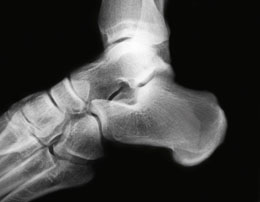A compound fracture is usually the result of high impact. This type of injury requires surgery in order to prevent infection and speed up recovery.

Compound fractures are usually due to heavy falls, car crashes, during fights or even a sustained fracture that is unattended for a long time. A compound fracture is generally considered to be a more serious form of fracture. It needs to be operated as soon as possible to quickly cleanse the injured area and realign the bone. In addition, because of the higher chances of infection, a compound fracture is more difficult to heal. Therefore, on sustaining a fracture, it is important to seek early treatment.
How to Determine A Compound Fracture
The main symptoms of a compound fracture include:
- Unbearable pain
- Affected part of the body appears deformed
- Swelling at the affected part
- Difficulty in moving the affected body part
Immediate Treatment Measures
☞ Massage the affected area with ice that is covered in a thin cloth or a bag. Direct massaging with ice may cause frostbite that may worsen the situation further.
☞ Make sure that you keep the affected area elevated, as you massage, to avoid further swelling.
☞15-20 minutes are enough for an ice massage, as prolonging it may cause more damage.
Treating a Compound Fracture while Outdoors
A compound fracture can be unnerving, as the injury is visible and chances are that it is bleeding profusely as well. You can summon for help immediately when you are in the city, but what if this occurs when you are in a remote area out to enjoy the trails?
☞ If this unfortunate incident takes place in the middle of the woods, and there is no human sign nearby, try to call for help anyway. You never know if there is help available. Until then, if the injury is on a moving part of the body like arms or legs, keep it elevated and clean it with water to avoid any form of bacterial infection.
☞ If the injured person needs to be moved immediately to the city immediately, first make sure that the injured bone remains stable, by padding both sides of the injury with thick flat wood pieces and stuck in place with a medical tape, if available, or even with vines and creepers. Keep a check on the bleeding as well. Clean it with water and a clean cloth.
Medical Attention
✔ Treatment of a fracture involves the realignment of the ends of the fractured bones, and immobilization of the fracture, either by fixing the bone internally or by using external splints. The goal of such treatment is to assist the bone in recovering its movement, strength, and sensitivity.
✔ The larger bones, such as the femur, or the thigh bone, which extend from the pelvis to the knee, are often difficult to realign and hence, internal nailing is prescribed for adults. In case of children, traction may be required for two days or more, before the bone is set in a cast.
✔ Once both the ends of the fractured bone begin to heal, plaster of Paris is used to immobilize the hip and leg joint. Or, in other instances, a general anesthesia is administered to the patient and pins are inserted to realign the bone, both below and above the fractured area, which are then fixed to a fixator, or an external frame, in order to restrict any movement of the affected area.
✔ Instead of using a plaster, a splint or sling is usually used in order to immobilize the toe bones or the collarbone. If the bones in the ankle are fractured, plates and screws may be inserted to realign them.
How Long does a Compound Fracture take to Heal?
Depending upon the severity of the fracture, physical health of the patient, age and also the time taken to start the treatment; the healing time for a compound fracture could vary.
- Among adults, the effects of treatment can be detected in about 6 weeks, via an X-ray, while it is observed earlier in case of children.
- This detection is just the beginning of the healing process. However, it will take about 18 months for the bone to recover completely, and regain its strength
Due to the injury that the bone and the surrounding tissue sustains, and also because of the higher rate of complications caused by possible infections, compound fractures need to be treated with utmost care.
Disclaimer:
The information provided in this article is solely for educating the reader. It is not intended to be a substitute for the advice of a medical expert.


 Compound fractures are usually due to heavy falls, car crashes, during fights or even a sustained fracture that is unattended for a long time. A compound fracture is generally considered to be a more serious form of fracture. It needs to be operated as soon as possible to quickly cleanse the injured area and realign the bone. In addition, because of the higher chances of infection, a compound fracture is more difficult to heal. Therefore, on sustaining a fracture, it is important to seek early treatment.
Compound fractures are usually due to heavy falls, car crashes, during fights or even a sustained fracture that is unattended for a long time. A compound fracture is generally considered to be a more serious form of fracture. It needs to be operated as soon as possible to quickly cleanse the injured area and realign the bone. In addition, because of the higher chances of infection, a compound fracture is more difficult to heal. Therefore, on sustaining a fracture, it is important to seek early treatment.